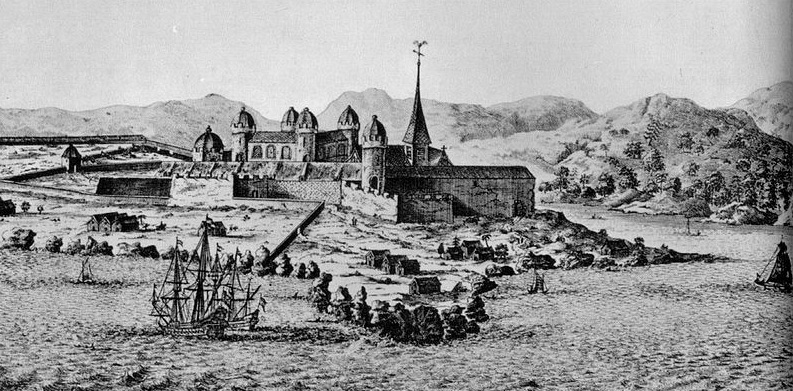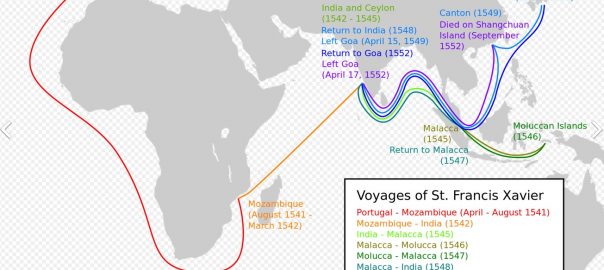In 1541 CE, of course Spain’s cruelly swashbuckling conquistadores continued their depradations in the Americas– from the Mississippi River down to southern Chile. Several other world-historically interesting things were happening too:
- Francis Xavier, one of the founders of the Jesuit order, left Lisbon on a mission to the Portuguese East Indies. I guess each empire-building monarch had his own preferred missioniaries at hand to give a “religious” gloss to his venture. (The map above is of his voyages.)
- French explorer Jacques Cartier set out on his third voyage to present-day Canada. This time, the intention of the monarch who sent him was not to find a “Northwest passage to the East Indies”. It was to continue to “explore” for potential mineral riches– and also to establish a permanent settlement on the banks of the St. Lawrence. Clearly the French king was suffering intense “colony envy” of his Spanish counterpart. Cartier’s expedition included five ships and at least some convicts among the potential “colonists”. They managed to survive their first winter (thanks to having learned of a local anti-scurvy remedy from the indigenous Iroquois.) But the precious metals they identified and took back en masse to France turned out to be quartz crystal and iron pyrites… and the little fortified settlement they built was abandoned in 1543. France would not establish a durable settlement in Canada until 1605. But Cartier had pioneered the use of domestic convicts as potential colonists, in an environment in which the Spanish and Portuguese had been using foreign assailants captured in battle.
- The English Parliament passed the Crown of Ireland Act, which created the title King of Ireland for Henry VIII and his successors. This set the scene for the Protestant Ascendancy in Ireland that was to come.
- In Ethiopia, Emperor Gelawdewos suffered a defeat from the Adali Sultan Imam Ahmad in April. Emperor G reached out to Portuguese adventurer (and “Governor of Portuguese India”) Estêvão da Gama, one of the sons of Vasco, who was commanding a fleet that had entered the Red Sea in January 1541. Estêvão responded to the pleas of a shady Portuguese character called João Bermudes (who claimed to be the Patriarch of Ethiopia?!?) that he send help to Emperor G, so in July he landed 400 men, 130 “military slaves” and supplies for them at Massawa so they could help Emperor G.
- Interestingly, between January and July 1541 Estêvão da Gama had sailed to the northern end of the Red Sea with the goal attacking the Ottoman port at Suez. But his plan was foiled when it became clear the Ottomans had long had advance notice of his raid. So he still had his full battle party ready on his boats as he came back to Massawa.
- In other Ottoman Empire news, the Ottomans were able to take Buda and incorporate Hungary into their empire and also to seal off the Golden Gate in the walls of Jerusalem that had been forced open by the Crusaders in 1102 CE.
- Flemish cartographer Gerardus Mercator printed and distributed the gores needed for two 18-inch globes: one terrestrial, the other celestial. The terrestrial one had new features of particular use to seaman, and the celestial one incorporated the heliocentric theories of Copernicus.
Centennial of first European slave-raid into Africa

This current “Project 500 years” writing project “started” in 1520 CE, being 500 years before the present year. But the story it explores, of how European-heritaged nations came to dominate (and maintain dominance of) the whole global order, had started a long time before 1520. And not just– as so many in today’s “West” like to imagine– in 1492 CE, the year of Columbus’s first contact with the Americas. Indeed, 51 years before that, in 1441, a conquistador from Portugal had undertaken one of the signal acts that over the course of the next four centuries would become a distinguishing feature of the West’s domination of the world: a slave-raid into sub-Saharan Africa to extract enslaved people for the sole benefit of European enterprise.
The Portuguese colonial adventurer in question was called Antão (also, “Antam”) Gonçalves. Two good places to learn about his actions are his (very brief) page on English-WP, and this wonderful online resource center “African Laborers for a New Empire”, created by the Lowcountry Digital Library (LDHI) at the College of Charleston, SC.
All the pages in LDHI’s “African Laborers” collection are worth reading. In this one, we learn how, one night in 1441, Gonçalves,
led a raiding party into Cap Blanc, a narrow peninsula between Western Sahara and Mauritania, and kidnapped two Berbers, one man and one woman. Another Portuguese mariner, Nuno Tristão, and members of his crew soon joined Gonçalvez. Although the raid resulted in less than a dozen captives, Zurara imagines in his account that prince Henry of Portugal responded to this enterprise with, “joy, not so much for the number of captives taken, but for prospect of other [countless] captives that could be taken.”
The following year,
Gonçalvez returned his Berber captives to Western Sahara, receiving as payment ten enslaved sub-Saharan Africans, whom he then transported back to Portugal for re-sale.
Fifteenth-century Iberian legal traditions regulated Christians’ treatment of Jews, Muslims, and other Christians, clearly delineating, for example, who was enslaveable and who was not. In contrast, the juridical status of people who did not fit these categories was more ambiguous. Legal and philosophical arguments to address this issue began to evolve during the second half of the fifteenth century, once Portuguese mariners began to return to Iberia with captives acquired in West Africa and West Central Africa. Notably, the treatment of “black Gentiles” was addressed in 1452 and 1455, when Pope Nicolas V issued a series of papal bulls that granted Portugal the right to enslave sub-Saharan Africans. Church leaders argued that slavery served as a natural deterrent and Christianizing influence to “barbarous” behavior among pagans. Using this logic, the Pope issued a mandate to the Portuguese king, Alfonso V, and instructed him:
. . . to invade, search out, capture, vanquish, and subdue all Saracens and pagans whatsoever …[and] to reduce their persons to perpetual slavery, and to apply and appropriate to himself and his successors the kingdoms, dukedoms, counties, principalities, dominions, possessions, and goods, and to convert them to his and their use and profit . . .
Also, this:
Portuguese mariners soon learned that inhabitants along the Upper Guinea coast were more than capable of defending themselves from such incursions. Not long after his 1441 voyage, Tristão and most of his crew were killed off the coast of present-day Senegal.
So that slave-raiding instruction from the Pope was originally issued just to the king of Portugal. As we have seen earlier, after the Castilian/Spanish monarchy entered the contest for world domination in 1492, the Pope was swiftly persuaded to clarify, in the Treaty of Tordesillas of 1494, that while the Portugal could (and should!) continue to act exactly as it wanted in terms of exploiting lands, peoples, and resources east of a line running at the line approximately 46° 37′ west of the Greenwich meridian, Spain could (and should!) do the same in all lands discovered to the west of that line.
That meant that, per the Pope, Spain could not have any direct access to the shores of Africa for slave-raiding purposes. But the other European conquistadoring powers that would emerge later, such as England, France, Netherlands, and even Denmark and Sweden, felt no compunction to respect the “rights” the Pope had assigned to Portugal in this regard. So merchants, mariners, and adventurers from all those powers would in later centuries join Portugal in building slave-raiding fortresses along the West African coast.
As for the Spanish, in many places in the Americas where they built plantations and colonies, they fairly soon exhausted the supply of local labor that they were able to exploit through genocide, over-work, brutality, etc. And when they needed more labor to exploit they would simply buy enslaved Africans from slave-traders of those other nations.
